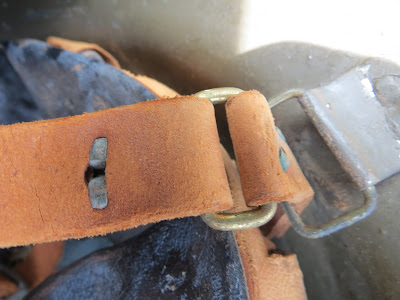The "tin lid"
The m.1917 is the American version of the British mk.I "Brodie" helmet. 700,000 British Brodies were supplied to the American forces before production began in the United States. This is one of those British-made American helmets utilized by
the "doughboy" of the Great War.
The dishpan-like Brodie served various nations well into the 1970s.
An identifying characteristic of this British-manufactured m.1917 is the lapped rim strip.
The American manufactured version of the Brodie
can be identified by the rim affixed with a butt joint.
The British-manufactured M1917 attaches the chinstrap bail with a split-pin...
the American-made helmet has a rivet attaching the bail.
The helmet on the left has the original factory finish of sawdust, and that on the right is a depot refurbished finish of coarse sand. Both are American helmets.
The chinstrap is adjusted with a robust iron buckle.
The single copper rivet, which passes through the crown of the shell, is the only attachment point for the entire liner and chinstrap. If the leather strap breaks, the helmet becomes worthless to the wearer. This is not a particularly thoughtful piece of
engineering, in my opinion.
Here the top strap passes through the chinstrap bail and attaches,
by a separate connector, to the chinstrap.
by a separate connector, to the chinstrap.
A name is penciled on the chinstrap.
The suspension of the Brodie-type helmet is not particularly elegant, in fact it is quite complicated and not as effective as later helmets. The headband has uniform slits of which the alternate pairs secure an inch-long piece of tubular rubber, providing some spacing and perhaps shock absorption between the helmet shell and the head of the wearer.
This complex web of netting has a drawstring to tighten or loosen it to adjust the fit. This seems to me to be an overly elaborate system.
The m.1917 design would soldier on well into the opening days of America's entry into the Second World War, though with a much improved liner and suspension, which I profiled in and earlier post which can be viewed here.
And now: a graphic salute to the American doughboy.
"The Machine Gunner" by Harvey Dunn
See you next time with another cool helmet from the collection.
Mannie




























No comments:
Post a Comment